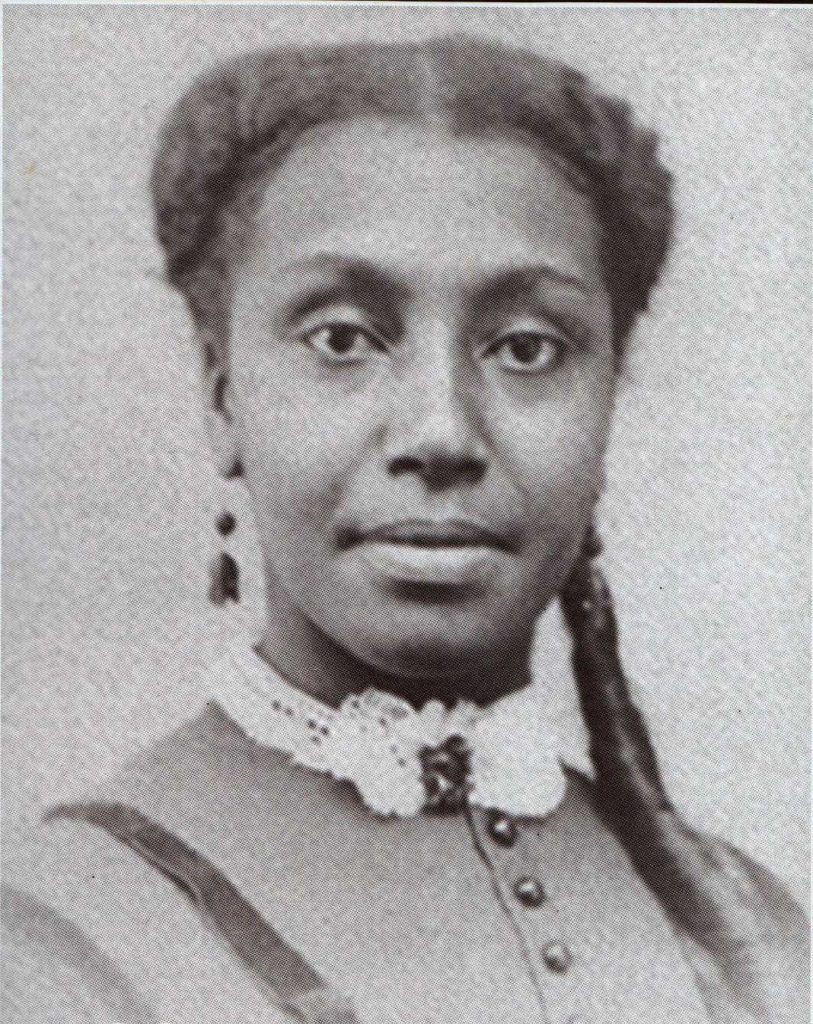FIVE PROMINENT BLACK AMERICANS
WITH CONNECTIONS TO FALL RIVER, MASSACHUSETTS
by Stefani Koorey PhD
Thomas J. Brown
Ernie Fleming
Sarah Anna Lewis
John Lee Love
William D. Tompkins
THOMAS J. BROWN
— Minority Rights Advocate and Business Administrator —
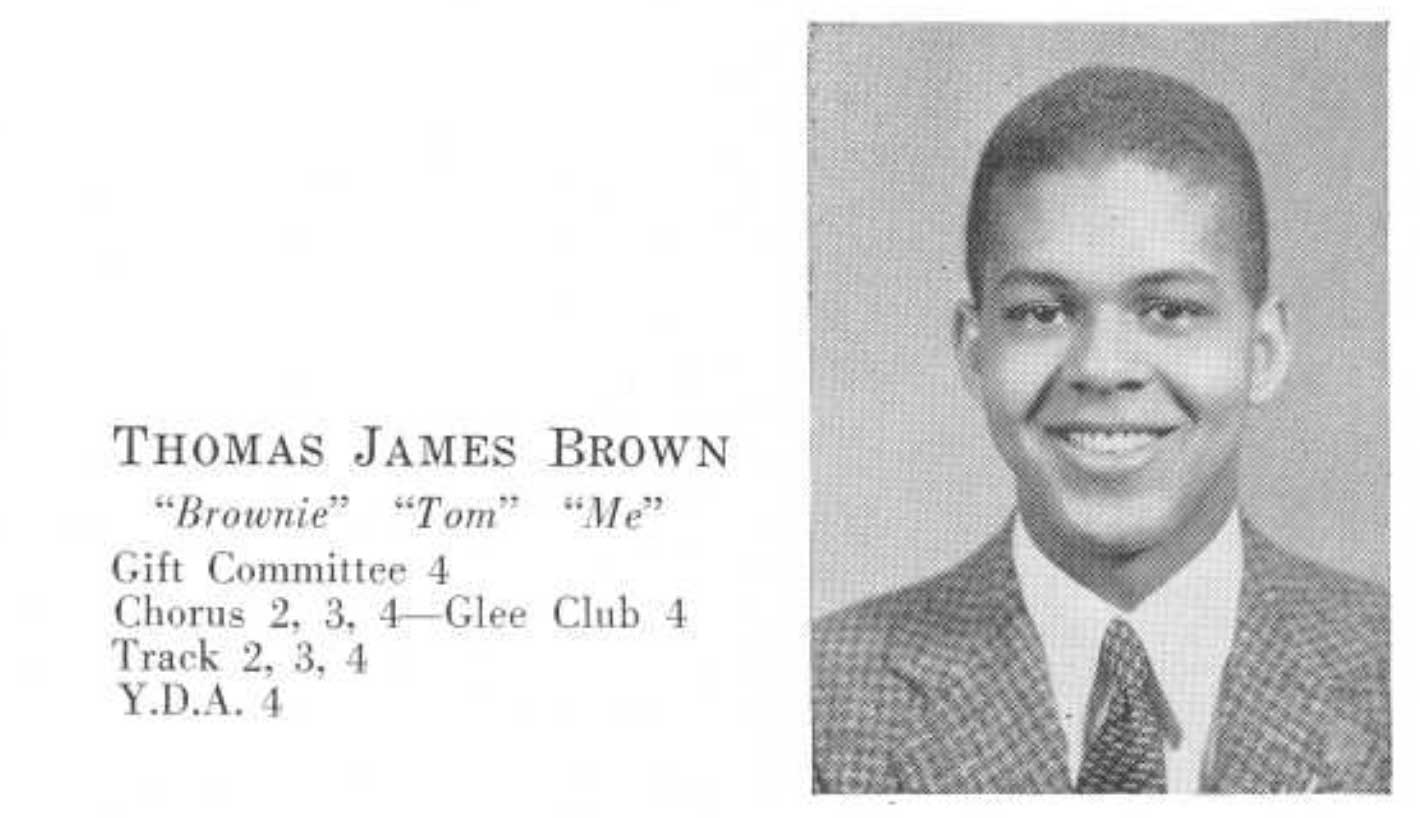
Thomas James Brown was born in Fall River, Massachusetts, on January 28, 1925, one of four sons and a daughter born to master mechanic William H. Brown and Bessie C. Brown.
Brown was educated in local public Fall River schools and attended B.M.C. Durfee High School, graduating in 1942. While at Durfee, Brown was voted Best Personality.
In 1987, when Durfee High School awarded him the Distinguished Alumni Award, he told the Fall River Herald News that he never suffered discrimination during his high school years.
“I really never even thought of it,” Mr. Brown told the newspaper. “I heard of it, of course, but personally it never touched me. I was carefree and I was young. Everyone at Durfee High was wonderful to me. I had loads of friends.”
Brown was the first African American student in the region accepted into DeMolay International, a young men’s leadership society begun in 1919.
Brown joined the Army at age eighteen, right out of high school, and served three years before returning to Fall River. He heard about the GI Bill and was accepted to Brown University, spending his college years in the Junior Chamber of Commerce. He graduated in 1950 with a degree in English.
In the early 1950s, Mr. Brown worked at Raytheon as a project coordinator before going into advertising.
In the early 1960s, Brown took a position as an account executive at the Marvin and Leonard Advertising Agency, the first African American to be employed at a management level in that industry. This spurred Brown to help other African Americans find careers. In 1963, he opened a small nonprofit in downtown Boston called the Jobs Clearing House. According to the Boston Herald, “He ran it for more than 30 years, never accepting compensation. During this time, more than 10,000 minority applicants found employment in higher-level positions than had been unavailable before. Business and educational leaders in Greater Boston acknowledged Mr. Brown’s achievements. His alma mater, Brown University, elected him to its board of trustees. He also was a member of Suffolk University’s board. As part of its 40th anniversary celebration, the Bay State Banner honored Mr. Brown as one of the individuals who had done the most in recent decades to improve the status of African Americans.”
As Brown told the Boston Globe in 1964, “I’m in this because somebody has to do it. I don’t call this a problem. It’s a situation. It’s a matter of semantics. A problem can be solved. A situation can only change — get better or worse. Take any problem and a computer can solve it for you. This situation is not going to be solved in our lifetime.”
Reported the Globe, “Job seekers never paid a fee and Mr. Brown took no salary. Grants from the Ford Foundation, Harvard University, and Boston business leaders paid the rent.”
In 1965, Brown left advertising and became a special assistant to Edwin H. Land, CEO and founder of Polaroid Corp. There he played an important role advocating for social change and job opportunities for Blacks.
According to the Globe, his family said that “a call from Land’s office to other Greater Boston CEOs would make it difficult for them to refuse to consider hiring racial minorities.”
“Mr. Brown’s longtime friend Melvin B. Miller, founder and publisher of the Bay State Banner, said Mr. Brown’s contributions to Boston’s black community are immeasurable. ‘We have a number of black heroes who have done extraordinary things,’ Miller said. ‘Their legacy is written on the souls of the people in a way they don’t even know it’s there.’ Miller said he and Mr. Brown worked to deliver minority candidates for jobs Mr. Brown unearthed in conversations with executives who said they could not find qualified minorities. Miller ran ads in the Bay State Banner for the positions and sent the candidates to Jobs Clearing House. ‘I understood the game and said, “OK Tom, here’s the deal, any time these guys try to set you up … we’ll run ads in the Banner. That was one of the ways the Banner became a major employment source for blacks together with Jobs Clearing House,” Miller said."
“Laughing as he recalled Mr. Brown’s audacity, Miller said that ‘it’s impossible for the younger generation to understand the chutzpah of him being a special assistant to Land and then using that office to call up the CEOs of companies and say, “I was down at your office the other day and didn’t see one black face. What’s going on?”’”
He was married to Inez Beverly Tinsley, daughter of Mr. and Mrs. Beverley Tinsley of Newport, Rhode Island, on June 29, 1952. Inez (Bev) was a graduate of the Hampton Training School of Nursing in Hampton, Virginia, and was on staff at the Boston Hospital. At the time of his marriage, Brown as employed by the Raytheon Manufacturing Company in Waltham, Massachusetts.
Bev often worked alongside her husband at the Jobs Clearing House. The nonprofit closed in the 1990s when they could no longer work long hours and had no one to replace them.
He served as a trustee at Brown and received a John S. Hope Award in 1997 for extraordinary commitment to volunteer public service.
According to the Globe, “Once retired, [the couple] spent evenings playing Scrabble. In winter, they went to West Palm Beach, Fla., where they enjoyed playing golf.”
Brown died of cancer on January 24, 2013, at the age of eighty-eight.
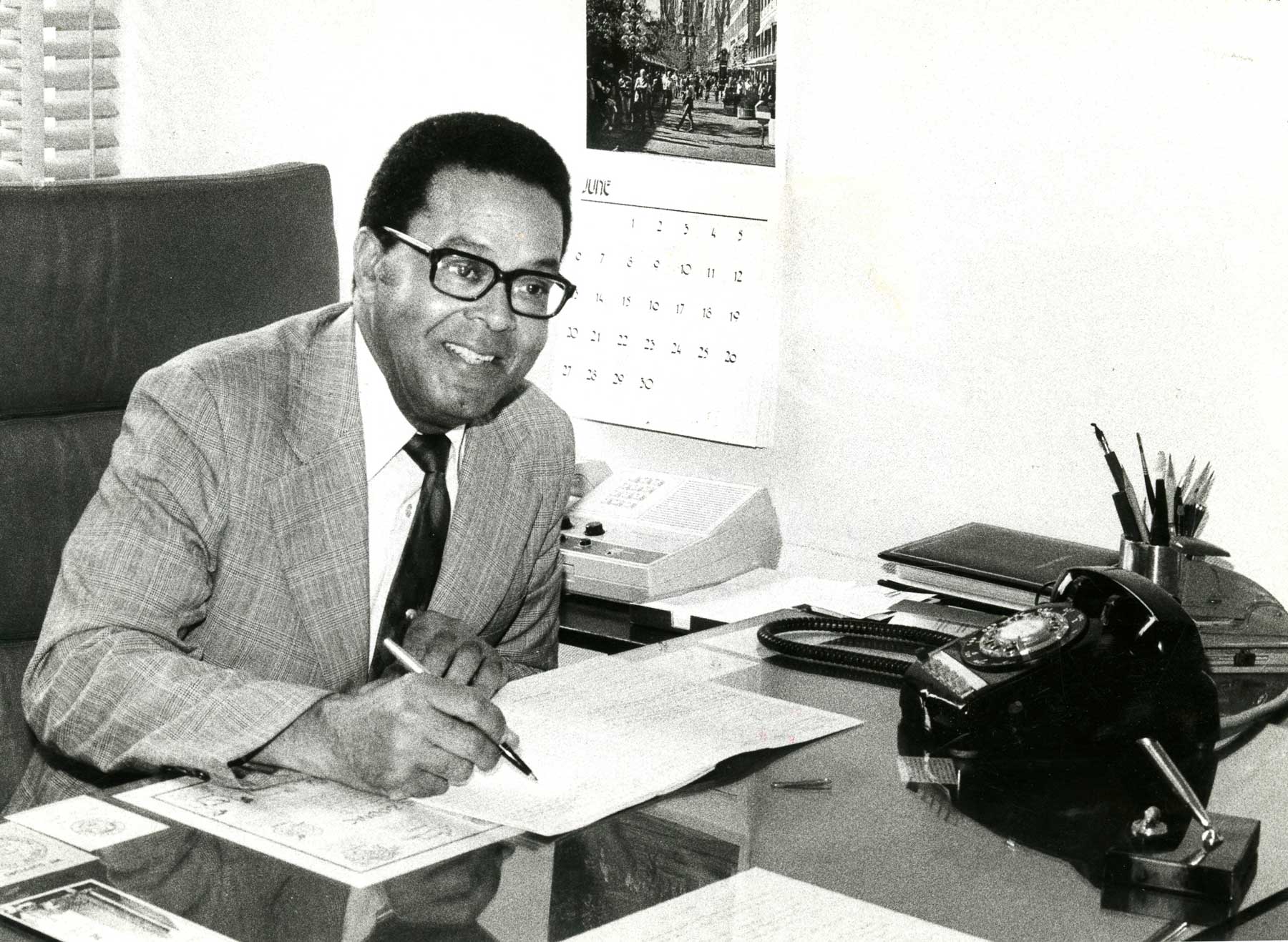
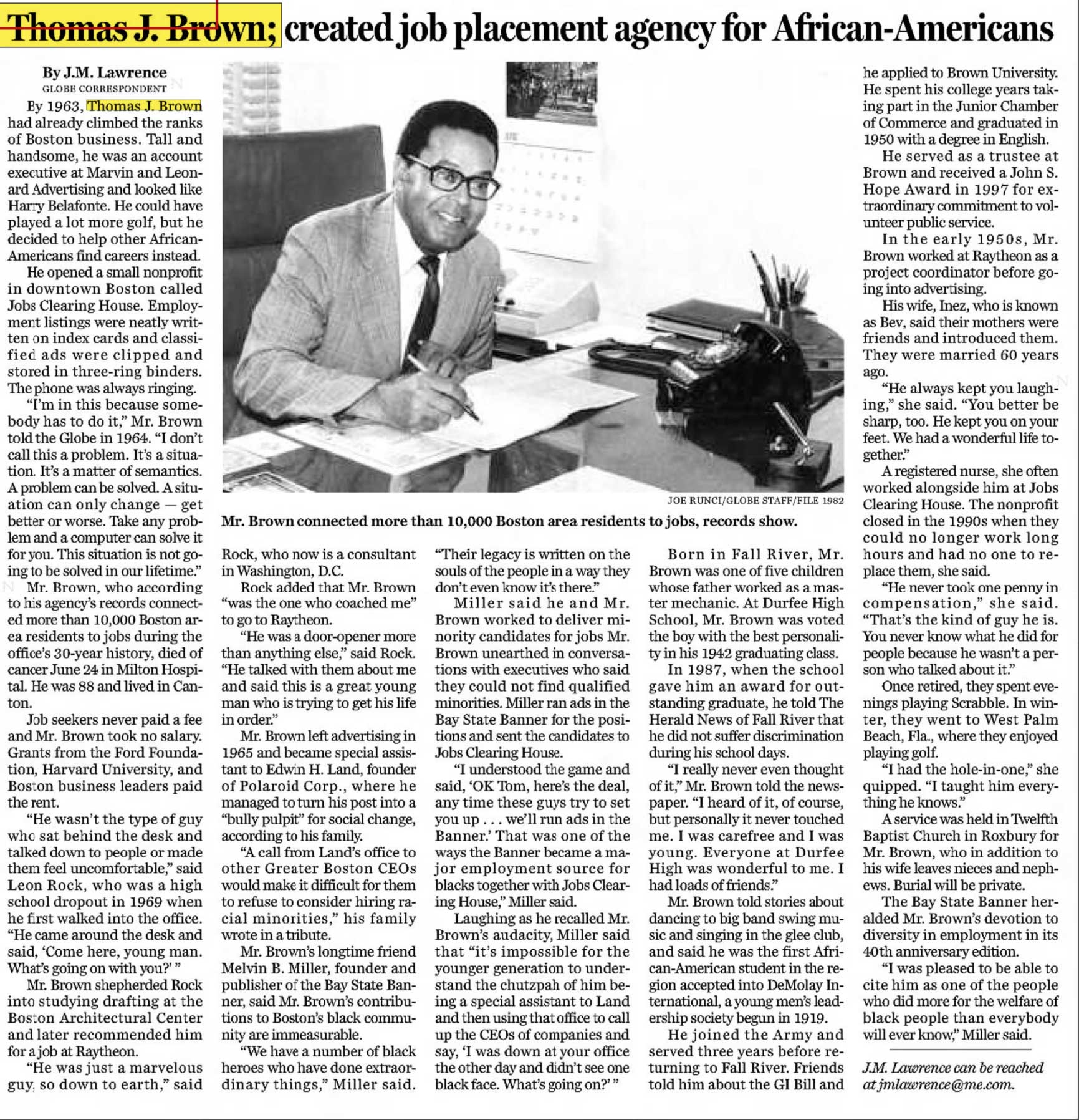
Sources: Cream of the Crop, Fall River’s Best and Brightest by John B. Cummings Jr (Hillside Media, 2014); US census records, 1930, 1950; Durfee Record, 1942; Boston Herald, June 30, 2013; Boston Globe, July 15, 2013.
ERNIE FLEMING
— Basketball Great —
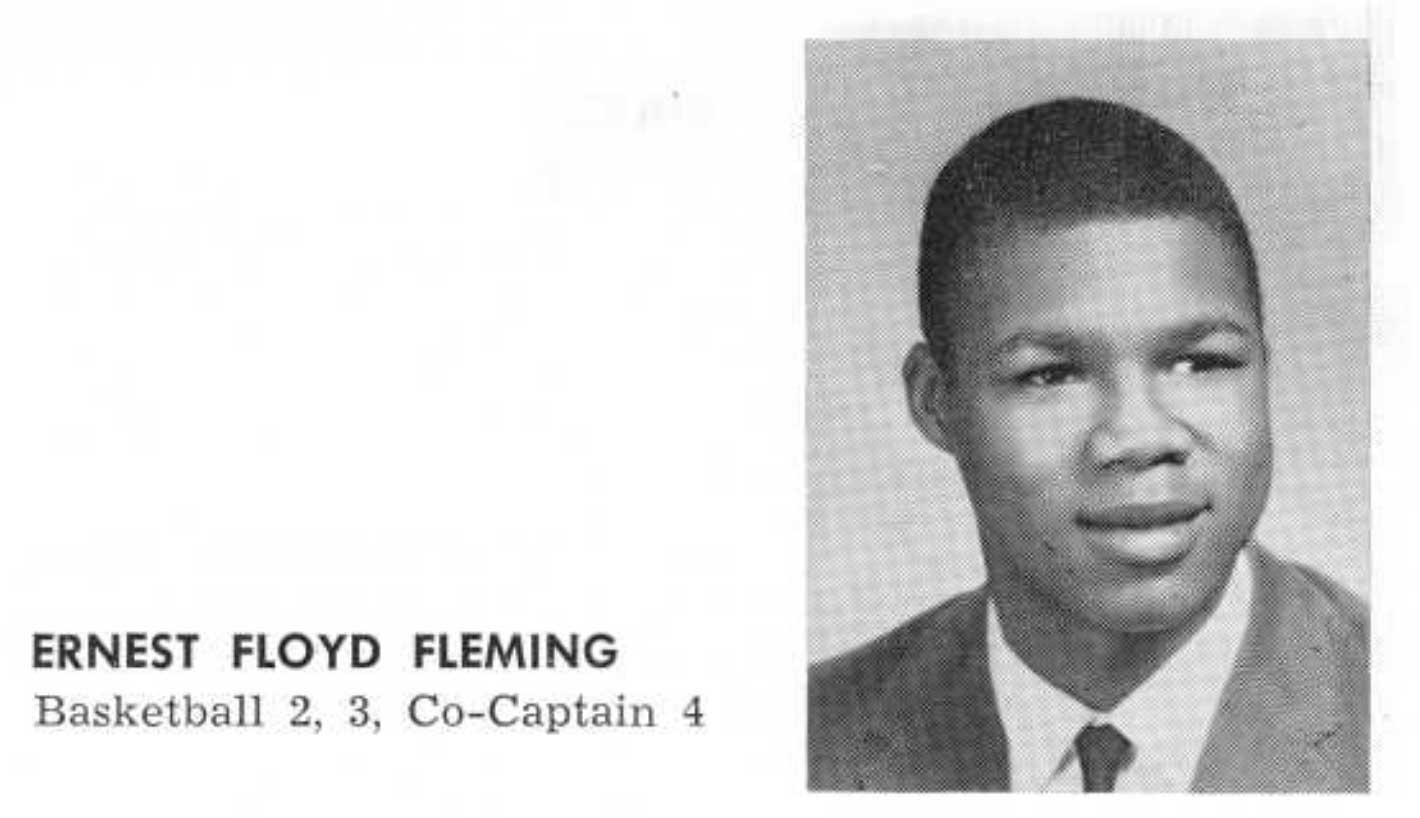
Ernest Floyd Fleming, or Ernie as he was always known, was born on April 28, 1948, in Fall River, MA.
Fleming, a 6-foot 5-inch center, was on the Durfee High School basketball team (graduating in 1967) and led the Hilltoppers to the 1966 Division I state championship and was named MVP. In his senior year, Fleming averaged 26.1 points per game and set a school single-game record of 50 points. He later played at both Gardner-Webb Junior College, in Boiling Springs, North Carolina, and Division 1 Jacksonville University, a private university in Florida (class of 1972, physical education). He is in the athletics hall of fame for both schools. While at Gardner-Webb, Fleming met and became close friends with later NBA Hall of Famer Artis Gilmore. According to the Fall River Herald News (March 7, 2016), the two men were close friends and “Gilmore accompanied Fleming on trips home to Fall River.”
Fleming played for the Jacksonville University basketball team from 1970 to 1972 and, just like at Durfee, helped lead the Dolphins to the 1971 NCAA Tournament and the 1972 National Invitation Tournament. In 1972, he led his team with 24.4 points per game and a .570 field goal percentage. Fleming held the all-time single game record in points scored (59 vs. St. Peters) and ranks eleventh in all time points scored with 1,115 in two seasons. He also ranked fourth all-time for field goals in a season with 262. In 1972, Ernie was named a Helms Foundation All-American.
For more information on his honors at JU, visit: https://judolphins.com/honors/hall-of-fame/ernie-fleming/59
After college, Fleming was drafted by the Detroit Pistons but never played in the NBA. He didn’t make the final preseason cut. He went on to a successful business career.
“A junior varsity player his sophomore year at Durfee, a reluctant Fleming was added to the 1965’s team roster for the Tech Tourney and state championship tourney at Boston Garden. ‘He didn’t want to go,’ Coach Skip Karam said. ‘He wouldn’t say it, but he was scared. The next year, he was the MVP of the tournament.’ Fleming not only grew but, through hard practice, developed a superb turnaround jumper, his bread and butter shot in high school.”
“As good as Fleming was in high school–26.1 points per game senior year; a then Durfee single-game record 50 points–his game blossomed at Gardner-Webb and Jacksonville as he added an outside shot to his high-jumping and powerful inside game.
“There were tough times, like dealing with segregation in the South. And like in the NBC-televised 1971 NCAA game when, with the eight seconds to go and the game tied, Fleming was called for a double dribble and Western Kentucky’s Clarence Glover, on a knee possibly pretending to tie his shoe, stood up to take the inbounds pass and score the winning layup.”
Fleming married on June 10, 1972, in Jacksonville, Florida, to Marchita Barnetta Mccrary. They divorced six years later in 1978.
According to the Herald News, Fleming “struggled with his health over the last decade of his life after suffering strokes. Greatly limited physically, he lived the final years of his life in a nursing home.”
He died at the age of sixty-seven in 2016 of cancer in Dallas, Texas.
Recently, on February 8, 2023, the Fall River Herald News named Ernie Fleming as one of the ten best high school basketball athletes ever to play at Durfee.
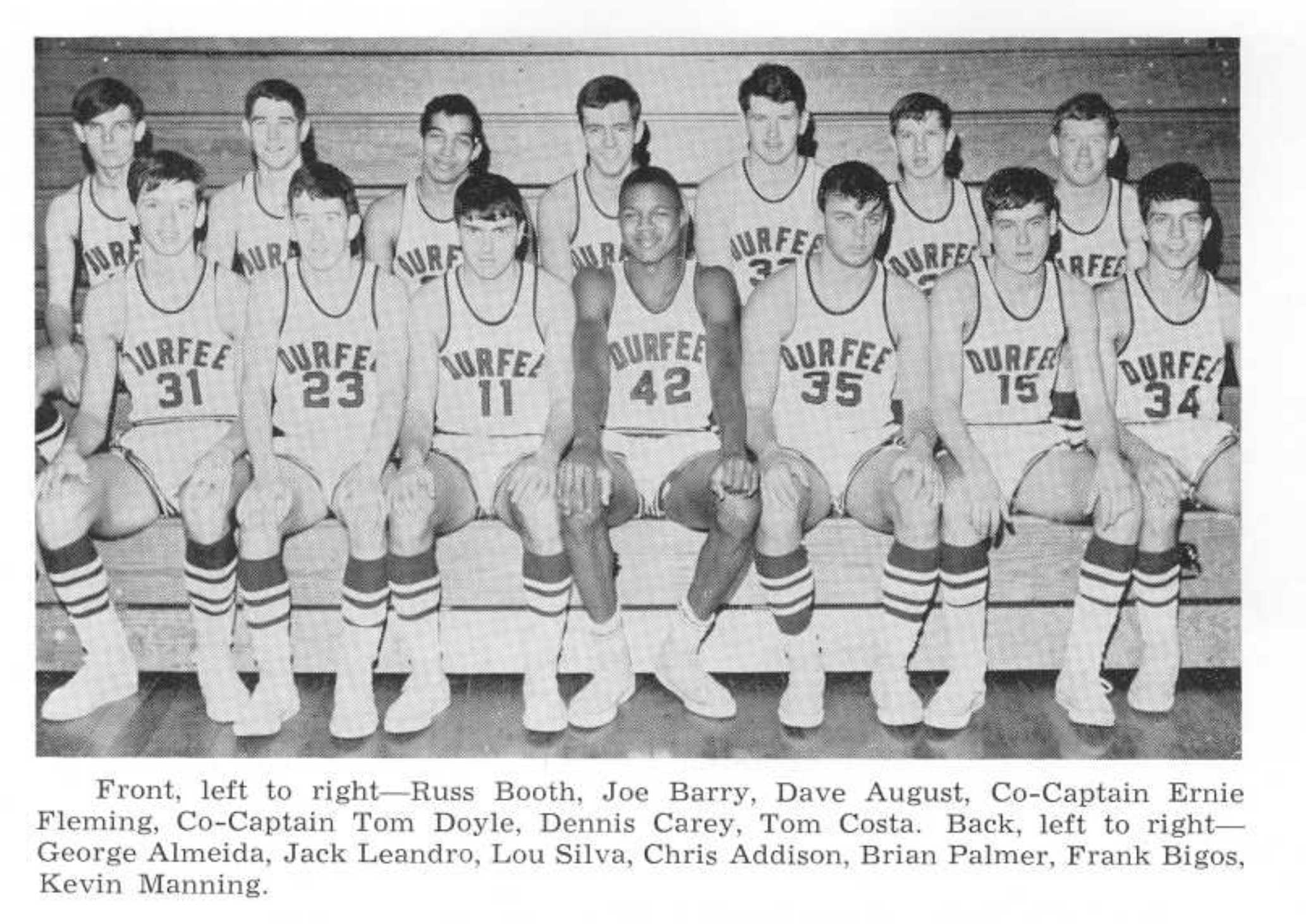


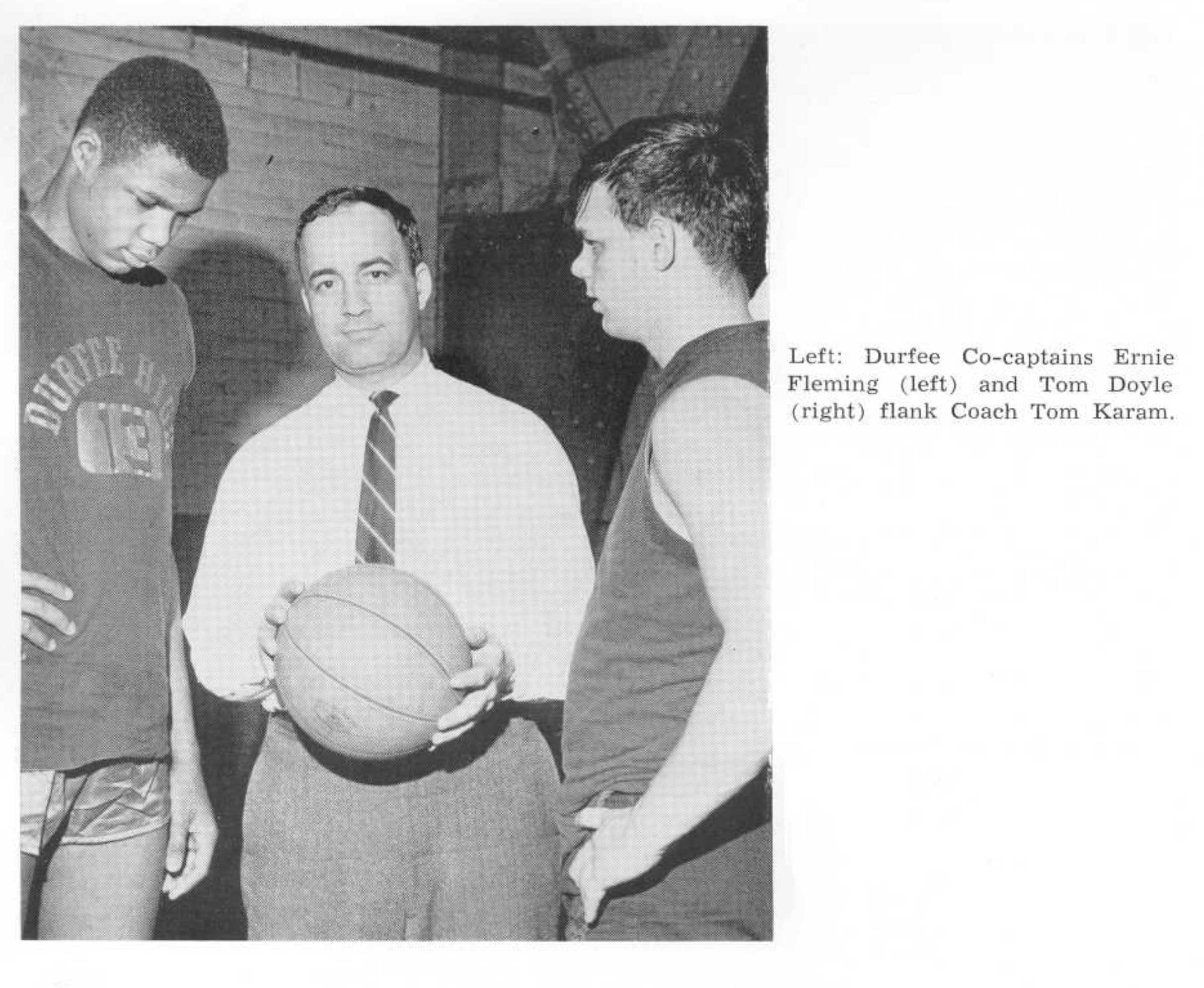
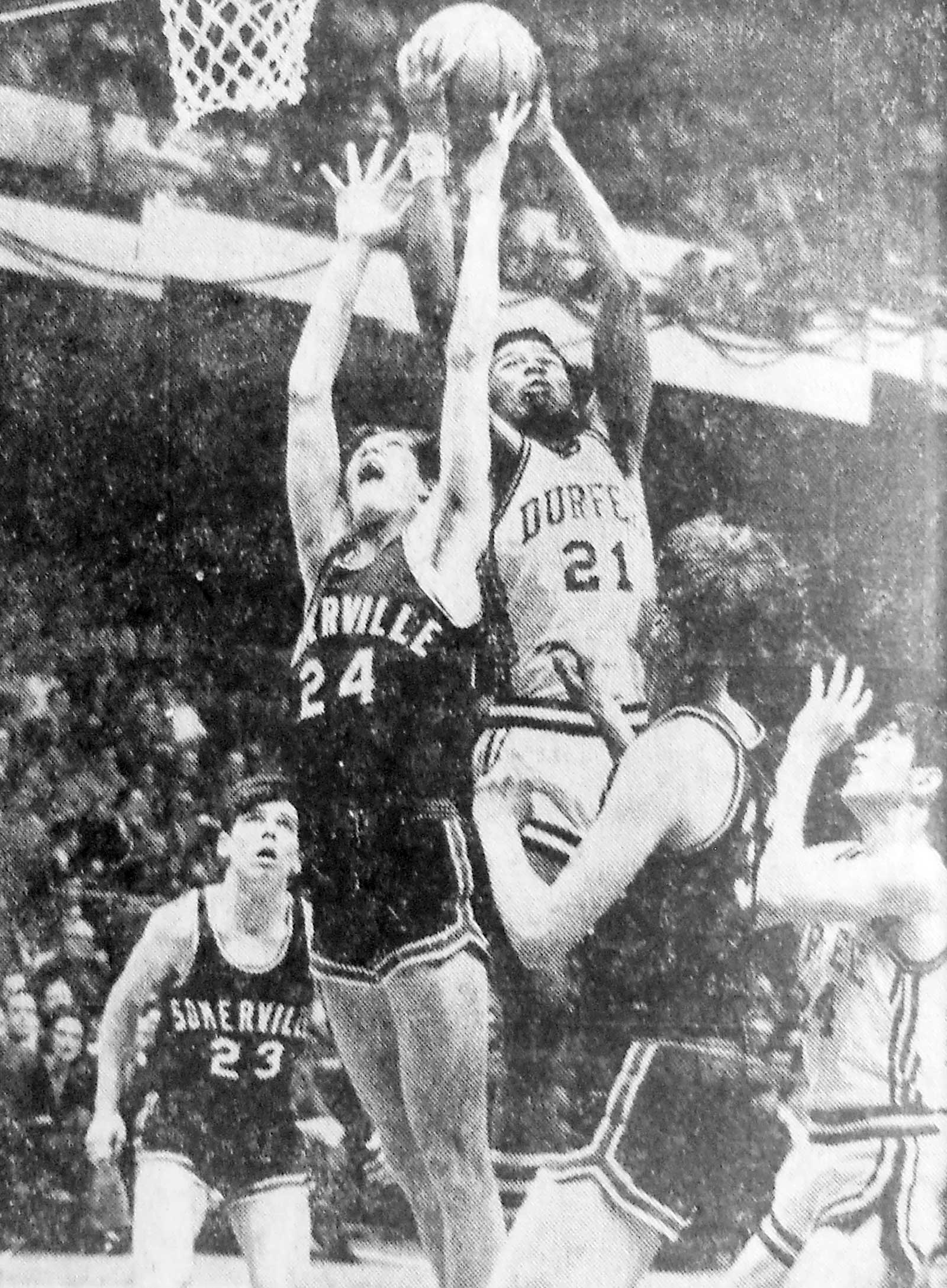

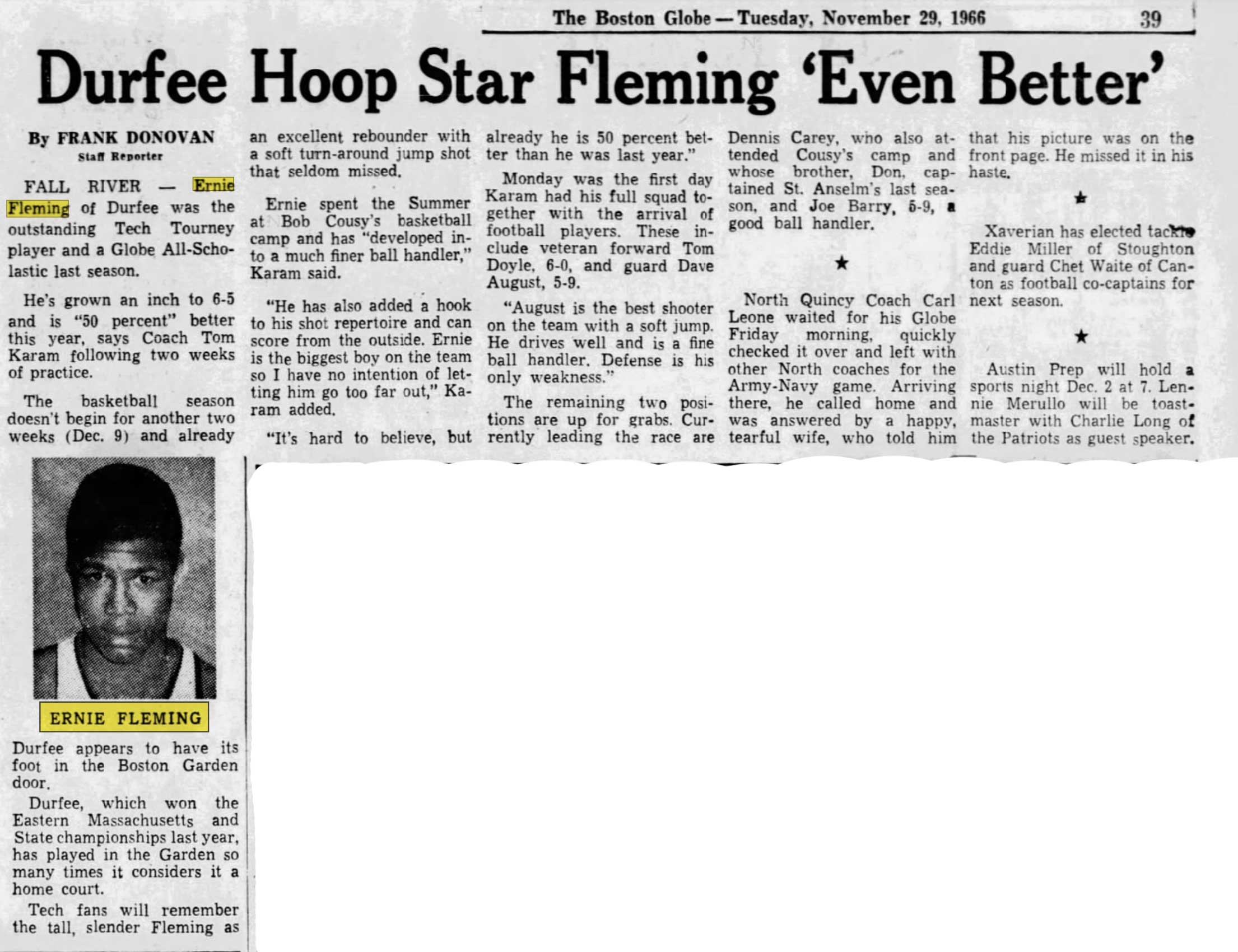

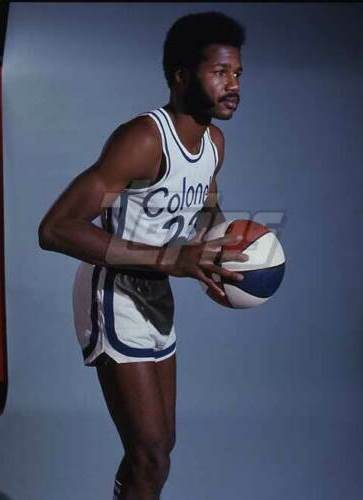

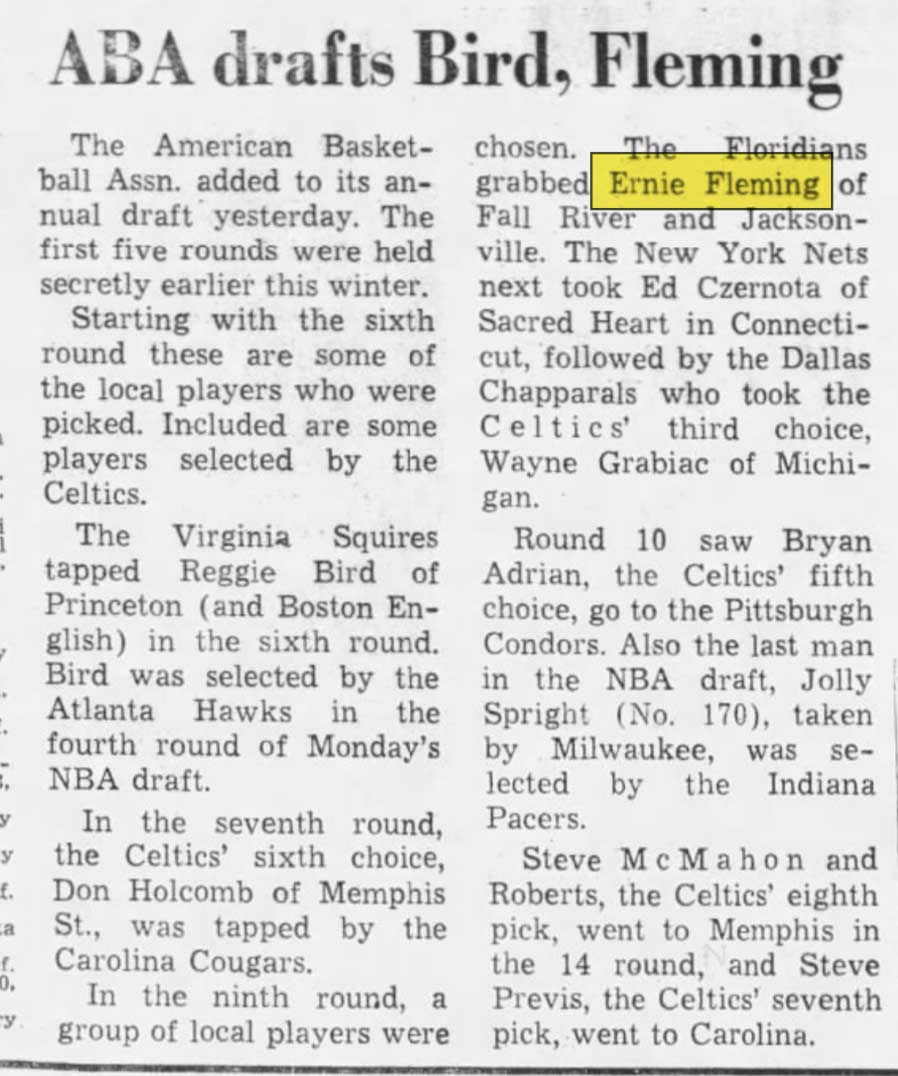
Sources: Herald News (February 8, 2023); Herald News (March 7, 2016); Durfee Record, 1967; JUDolphins.com; SouthCoast Today (March 8, 2016).
SARAH ANNA LEWIS
— First Black Person to Graduate from Bridgewater State University —
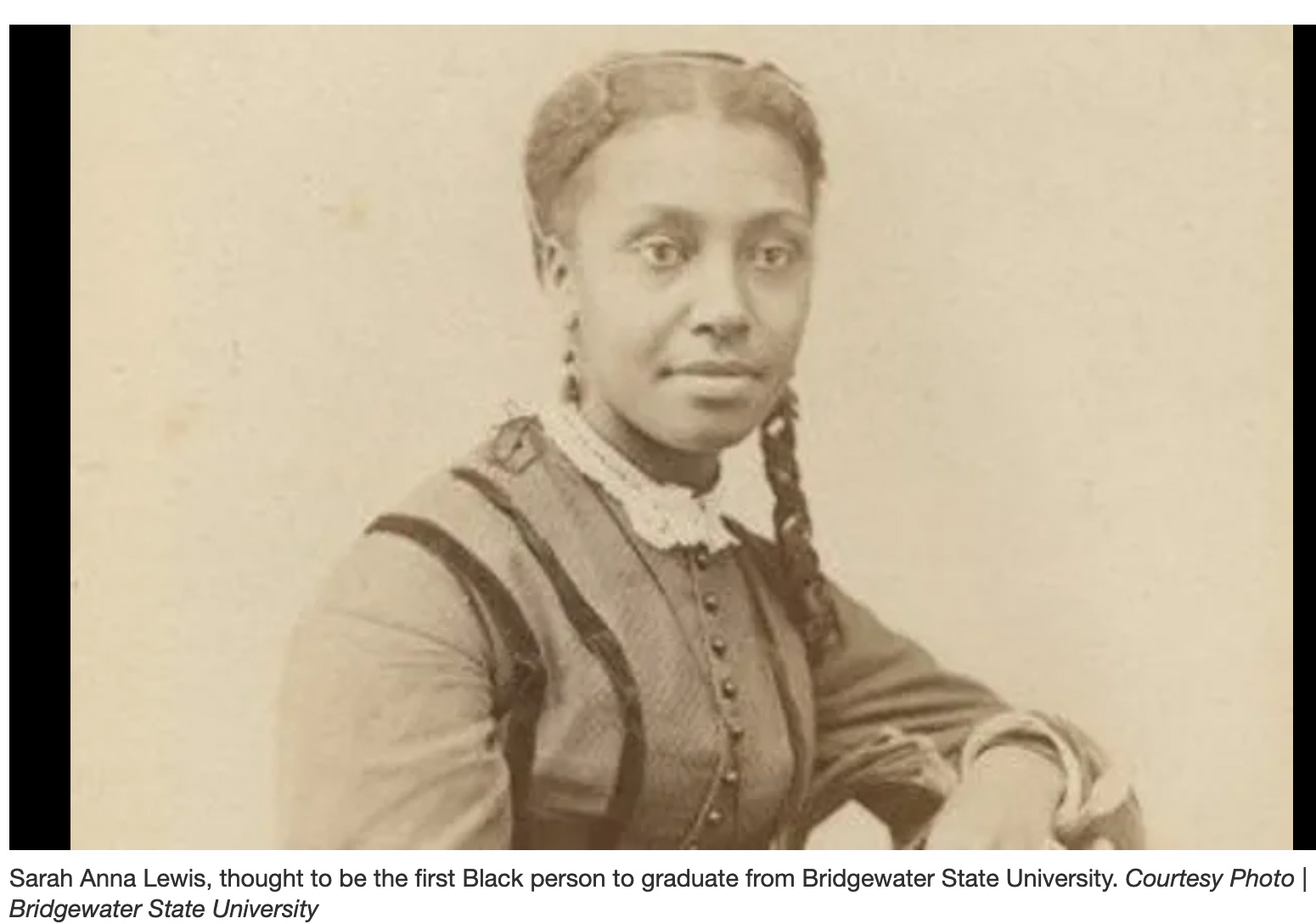
Sarah Anna Lewis was born on February 20, 1846, in Providence, Rhode Island. She was one of two children born to William and Louisa Lewis. At the time of her birth, over three million Black people were living in forced servitude in the United States. William was born in Rhode Island in 1819, and Louisa, who was a decade younger than her husband, was born in Savannah, Georgia, in 1828. By 1840, the couple were residing to Providence, Rhode Island. Her sister Mary was born on June 19, 1847.
William Lewis supported his family as a barber and, by 1857, had left Providence for a position as a coachman in Fall River, Massachusetts. By 1862, William was a waiter on the steam vessel Empire State, “an early member of the fleet of ships that in time became known as the Fall River Line. These luxury vessels carried passengers on round trip voyages connecting Newport and New York. Operating from 1847-1937, the Old Fall River Line was commonly regarded as providing the most sumptuous examples of coastline cruising available” (Silvia, “Sarah Anna Lewis”).
This employment provided enough financial stability so that Sarah, encouraged by her family, was able to pursue her desire for education rather than joining the mill workforce of Fall River.
Sarah excelled in the Fall River school system and passed her exam for admission into the Fall River High School, the precursor to B.M.C. Durfee High School.
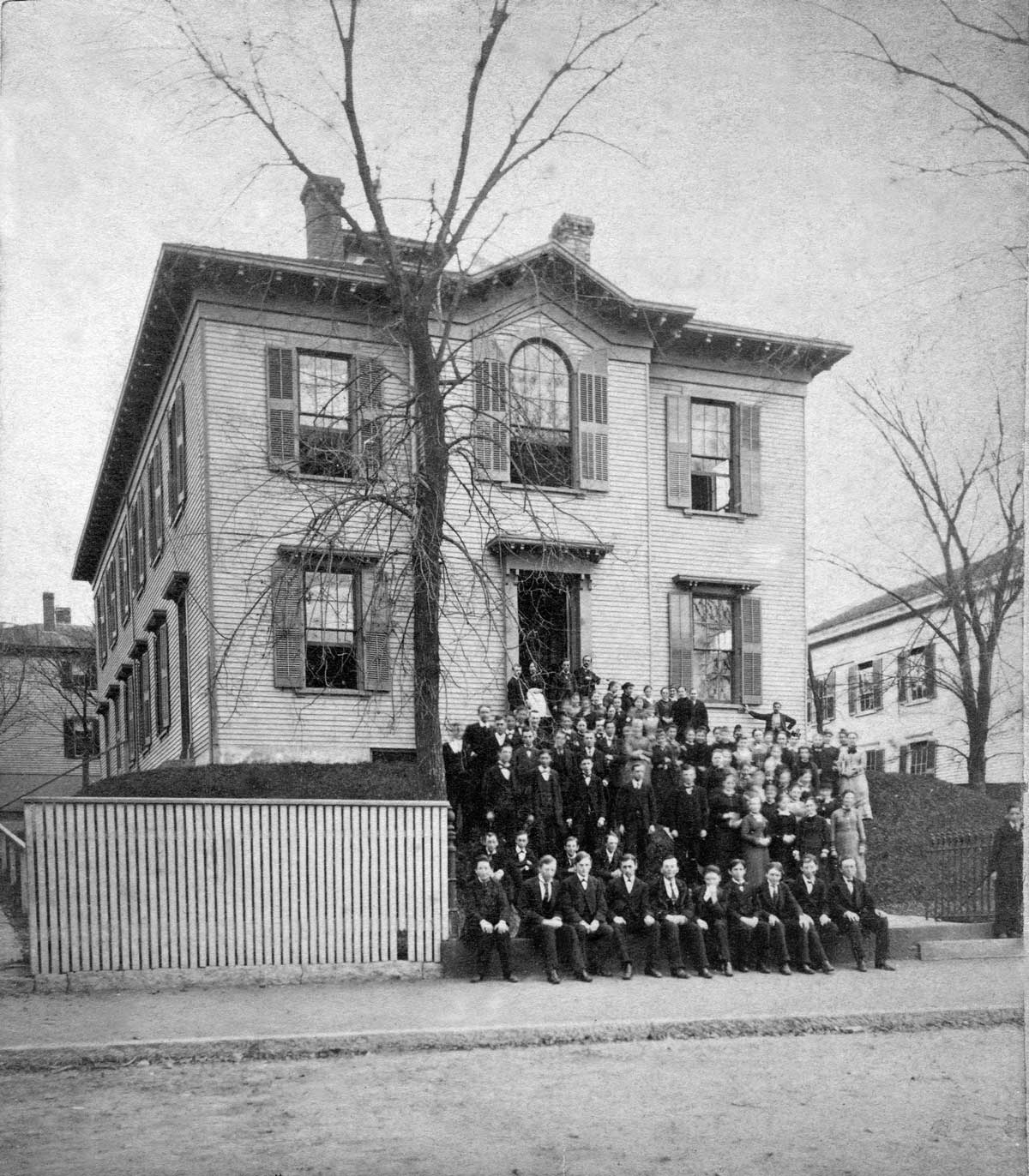
After graduation, Sarah taught for three terms in the Fall River school system.
In 1867, at the age of twenty-one, Sarah “submitted academic credentials exceeding the minimum course requirements for admission” (Silvia, “Sarah Anna Lewis”) into the State Normal School at Bridgewater, Massachusetts. She was accepted on February 19, 1867. As part of her admission, she signed an agreement to become a public school teacher in the Commonwealth of Massachusetts upon graduation. After three consecutive terms, Sarah earned her diploma on January 26, 1869, as one of seventeen graduates, and the first Black student to graduate from the school—before Harvard University, Massachusetts Institute of Technology, Brown University, or Tufts University.
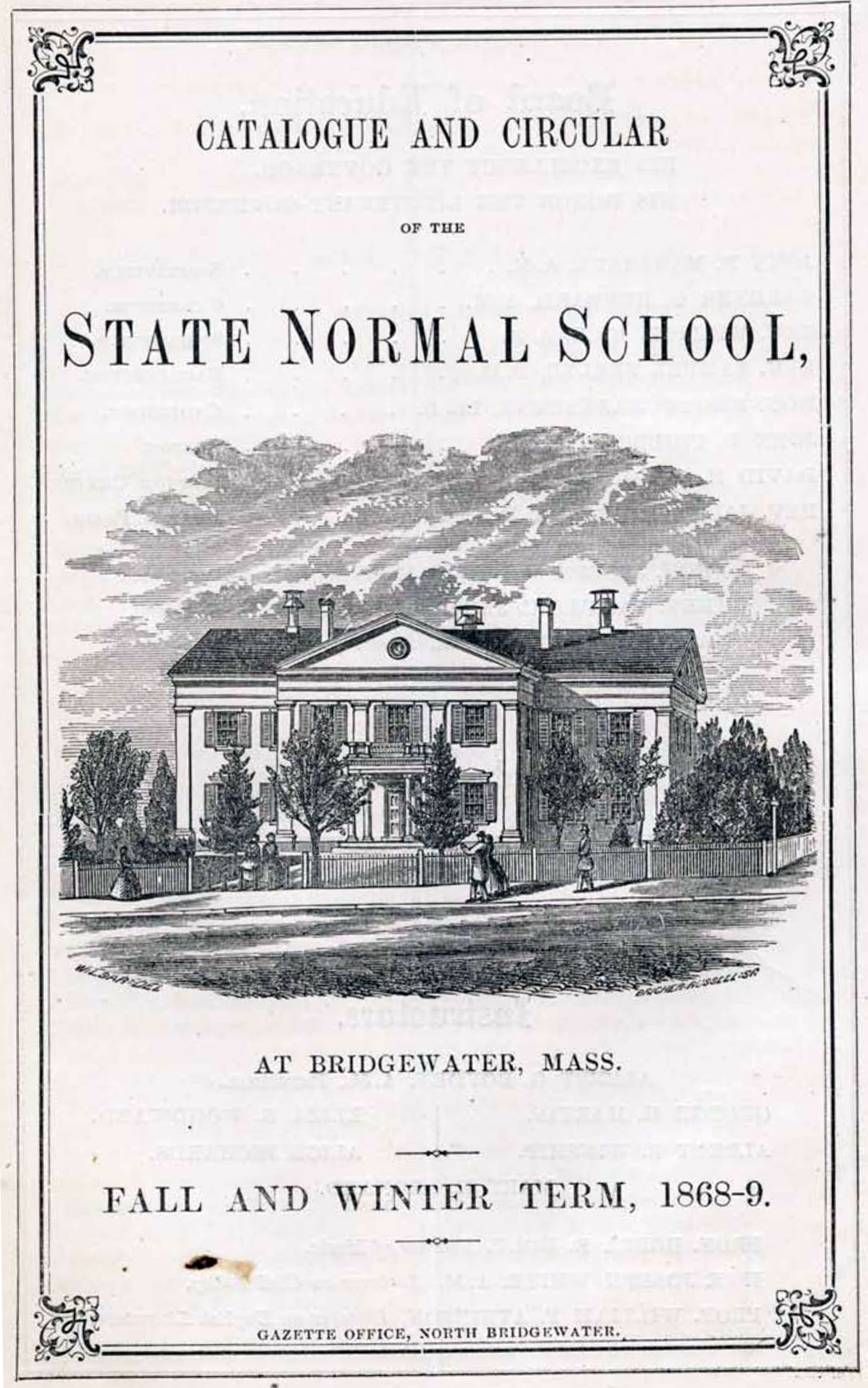

With the highly regarded Bridgewater degree, the Fall River school system hired Sarah Lewis as a full-time teacher. Sarah taught at the “1st Division Intermediate” school level, beginning in March 1869 and continuing for two academic years.
On May 11, 1871, in Fall River, Sarah married Edward A. Williams, a forty-six-year-old cook and a baker. Edward was born in Philadelphia, the son of James Williams and his wife, Harriet Lerkman. With this marriage, Sarah forfeited her employment as a school teacher as it was illegal for married women to teach, colloquially known as the “marriage bar.”
The reasons for this written and unwritten rule were several. According to Sabrina Thomas, a professor at Marshall University, in the nineteenth century, “young moral women would be a celibate class, temporarily extending their moral and social skills to be the teacher of young children” (Herald News, March 2, 2022). When a woman broke their celibacy, this ended. In addition, all married women at the time were expected to give themselves entirely to their husbands and children. The belief was that a woman could not commit herself to teaching children when she had other duties to perform in raising her own.
Without Sarah’s income as a teacher, the family struggled on Edward’s salary as a cook. The 1870s were a time of strikes and lowered wages in Fall River so, late in the decade, after the birth of a daughter (Florence Rebecca, 1877), the family relocated to Manhattan, where they lived relatively close to her sister Mary, who had by this time married Lewis Latimer, and lived in Bridgeport, Connecticut.
Sarah and her family soon returned to Massachusetts, living in Boston and Newton, and raised two more children, Ernest (born 1879) and Harriet, with Sarah supplementing the family income as a seamstress. Edward continued as a cook and a caterer until his death in 1902.
By 1910, Sarah was living in Everett, Massachusetts, with her married daughter, Florence Paris Morgan.
Sarah died at the age of ninety-two on January 24, 1939. She is buried in Oak Grove Cemetery along with her mother Louisa, husband Edward, daughters Harriet Pinkney and Florence Paris Morgan, sister Mary Latimer, brother-in-law Lewis Latimer, and their daughter Louise, “a final testament to fealty to a city that had provided some good opportunities in times past” (Silvia, “Sarah Anna Lewis”).
Sources: “Sarah Anna Lewis” by Philip T. Silvia Jr. (Bridgewater State College, n.d.); Herald News, March 2, 2022; Biographical Information, Bridgewater State College, https://vc.bridgew.edu/hoba/11/.
Very little is known about the life of John Lee Love. We know he existed and that he lived in Fall River, Massachusetts, during the years 1895 through 1897, residing at 13 Pine Street and, later, at 36 Fourth. His occupation was that of carpenter. We know that before Fall River, Love lived in Medford, Massachusetts, and his name appears on a voting record there in 1894. Between Medford and Fall River, Love lived for a brief period in Boston at 38 Buckingham. We know Love was an inventor as well, holding two patents—one awarded in 1895 for a Plasterer’s Hawk (a tool to hold a plaster, mortar, or similar material so that the user can quickly and easily get to the material, which is then applied to a surface) and another granted in 1897 for improvements on the Pencil Sharpener, later sold as the Love Sharpener. We don’t know how much income was earned from these inventions.
We don’t know exactly when or where Love was born, but we have a clue from the voter list from Medford—his birthplace is listed as Columbia, Georgia, and that he was thirty-one in 1894. His birth, then, would have been circa 1863. No birth certificate, however, has been located.
Census records for 1880, when Love was approximately seventeen, show him living with his father Jubilee Love, a drayman, his mother Amy, and his sisters Ella, Abbie, Lula, and brothers Charley and Willie. There is also a grandchild named Eddie, nine months old, living in the household, but it unclear who the parents are. Interestingly, both John and his sister Ella are listed at eighteen years of age, which may mean they were twins. Jubilee is but thirty-six years old, showing us that he started having children when he was eighteen and his wife was twenty.
John Lee Love never appeared in a census again, as far as we know.
Various sources online claim that Love died in a collision between a car and a train in Charlotte, North Carolina, in December of 1931. But this cannot be the same person—the death certificate lists this Love’s race as white, age forty-two, and an auto mechanic. Such are the perils of not paying attention to details.
We know that after Fall River, Love moved to Newport, Rhode Island, and lived there from at least from 1898 through 1906. He established himself there with his brother William H. as Love Brothers, boot blacking parlors, at two locations: 146 Thames and 14 Franklin. In addition, John is listed as a carpenter. The brothers boarded at 3 Swan Avenue.
A brief notice appeared in the Fall River Evening News on December 4, 1902, that “Mrs. Amy Love, mother of John L. Love, died … while being taken to the Newport Hospital. She was 65 years old and came here from Jacksonville a year ago to spend the rest of her days with her son in whose arms she died. She leaves five sons and two daughters.” As the oldest son, John was her primary caretaker.
John Lee Love appears in newspapers a total of seven times. Twice in 1897 for the awarding of the patent for the pencil sharpener improvement and twice for the announcement of his being elected assistant secretary of the Robert Adams Colored Republican Club at the A.M.E. Church on Maple Street. There is a strange article that appeared in the Fall River Daily Herald on March 30, 1896, where a John L. Love was discovered during a raid at the La Grange Hotel. “A colored man and a woman who gave their names as Mr. and Mrs. Brown of Boston were found in one room. When they had resumed their clothing, it had been learned that their names were John L. Love and Sarah Henderson, and that they were fairly well known about the town.” It seems Love’s arrest was overshadowed by the occupants of the other room—a well-known Fall River man of the cloth.
“John L. Love and Sarah Henderson pleaded guilty of fornication, and each paid a fine of $30.” This story also appeared in the Boston newspapers.
We do not know if this is the same John L. Love as the inventor, but there are no other John L. Loves in the Fall River city directories during this time. If it is, it may be one of the reasons why John moved to Newport shortly thereafter.
Lastly, and most oddly by our modern way of thinking, Love appeared twice more in the newspaper—both on the same day but on different pages (6 and 7) of the Boston Globe. In this case, what we see is a letter to the editor of the Globe, with the headline TAKE DOSE OF WATERMELON. EASY MEDICINE TO TAKE AND SAID TO BE VERY EFFECTIVE. I present it to you here without comment.
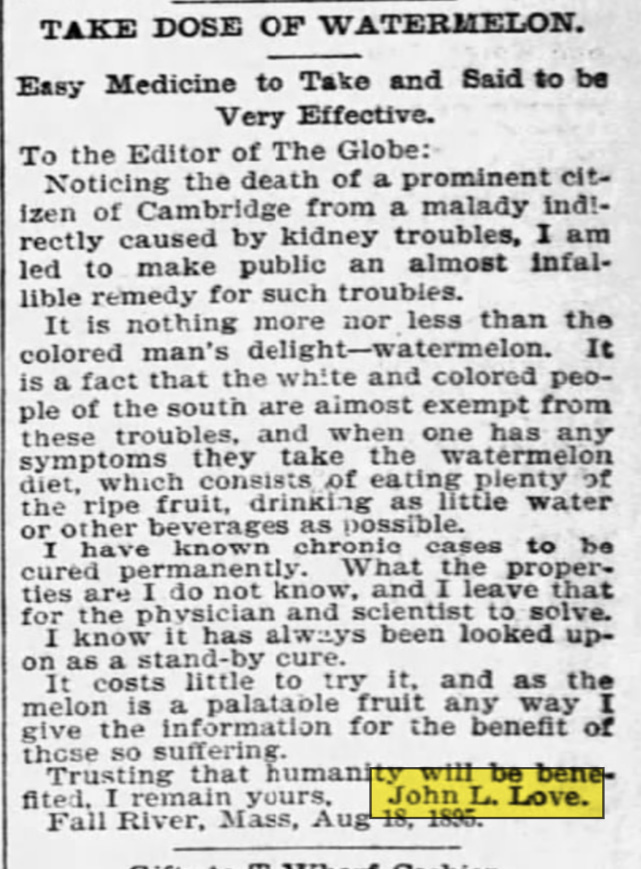
Nothing more can be found about John Lee Love after his disappearance from the Newport city directories in 1907. A nationwide search brings us no closer to locating him or determining when or where he died.
THE PENCIL SHARPENER
John Lee Love’s improvement on the pencil sharpener was substantial. He essentially added the hand crank to the device and a storage area for the shavings. Instead of turning the pencil against the blade, as portable sharpeners function, the blade in Love’s invention turned against the pencil by the circular motion of the crank. In his application, Love said that they could be manufactured as an ornate item and used also as a desk ornament or a paperweight.
In an article on February 1, 2013, in the Fall River Herald, John T. Duffy, a Connecticut lawyer and marketing consultant who grew up in Fall River, “unearthed Love’s story while researching patents issued to Fall River residents in the 1800s.”
Duffy noted that Love’s patent application indicates that he had legal representation. He had hired law firms from Boston and NYC to represent him on both of his patents.” Said Duffy, “The thing that impressed me was the financial resources and backing that he must have had. That is a very intriguing element to all of this as well.”
Let us add to this information that John Lee Love additionally secured an international patent for his “Improvements in Pencil Sharpeners” in the United Kingdom of Great Britain and Northern Ireland on May 17, 1897.
An abstract from that patent: “Pencil sharpeners; paper-weights.-The cylindrical casing 5 is provided with an in-turned toothed edge 9, which gears with the toothed wheel 19 on the pencil sharpener 13. The pencil is inserted in the sharpener 13, which is caused to revolve on the arm 12, and is rapidly rotated by means of the toothed gearing. The appliance may be used as a paper-weight.”
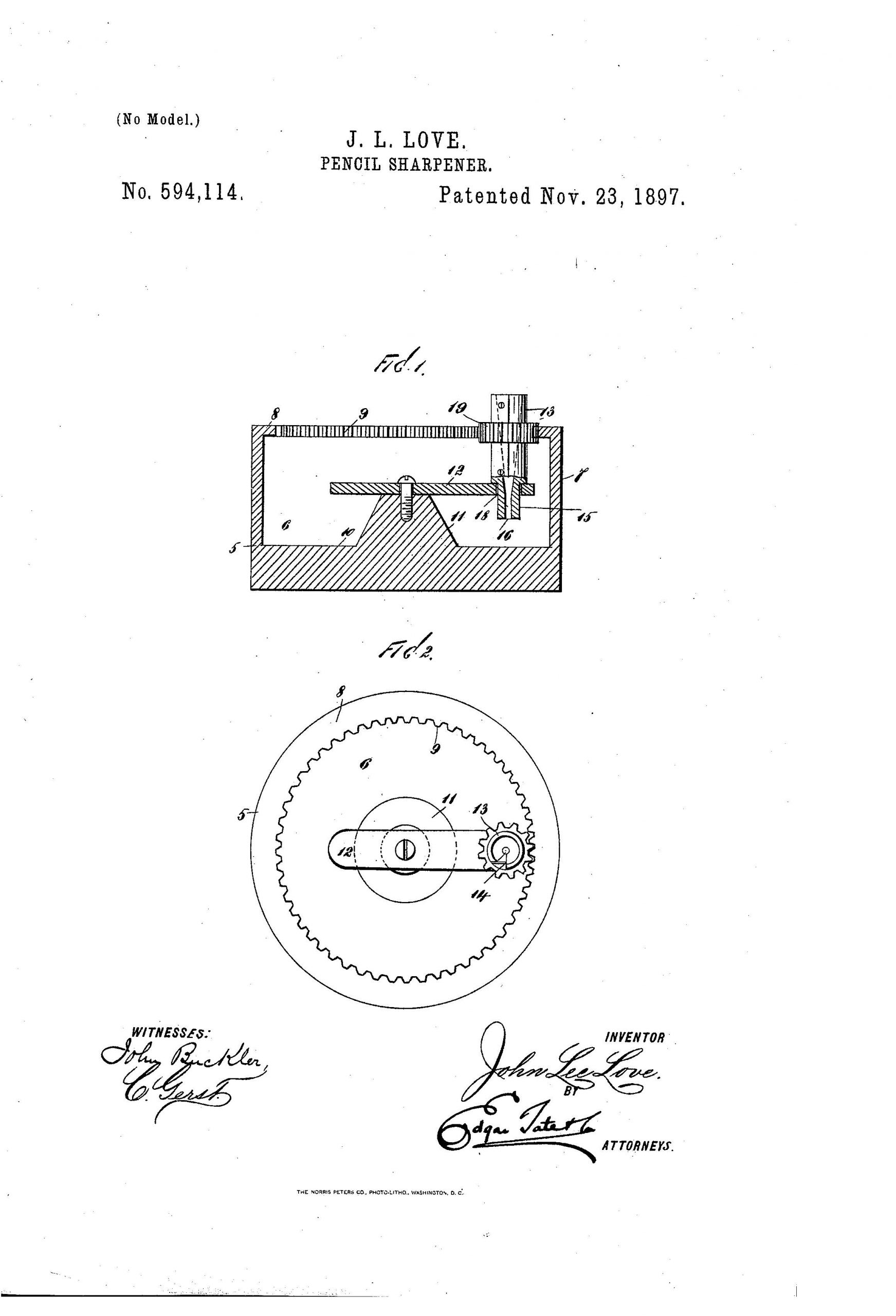
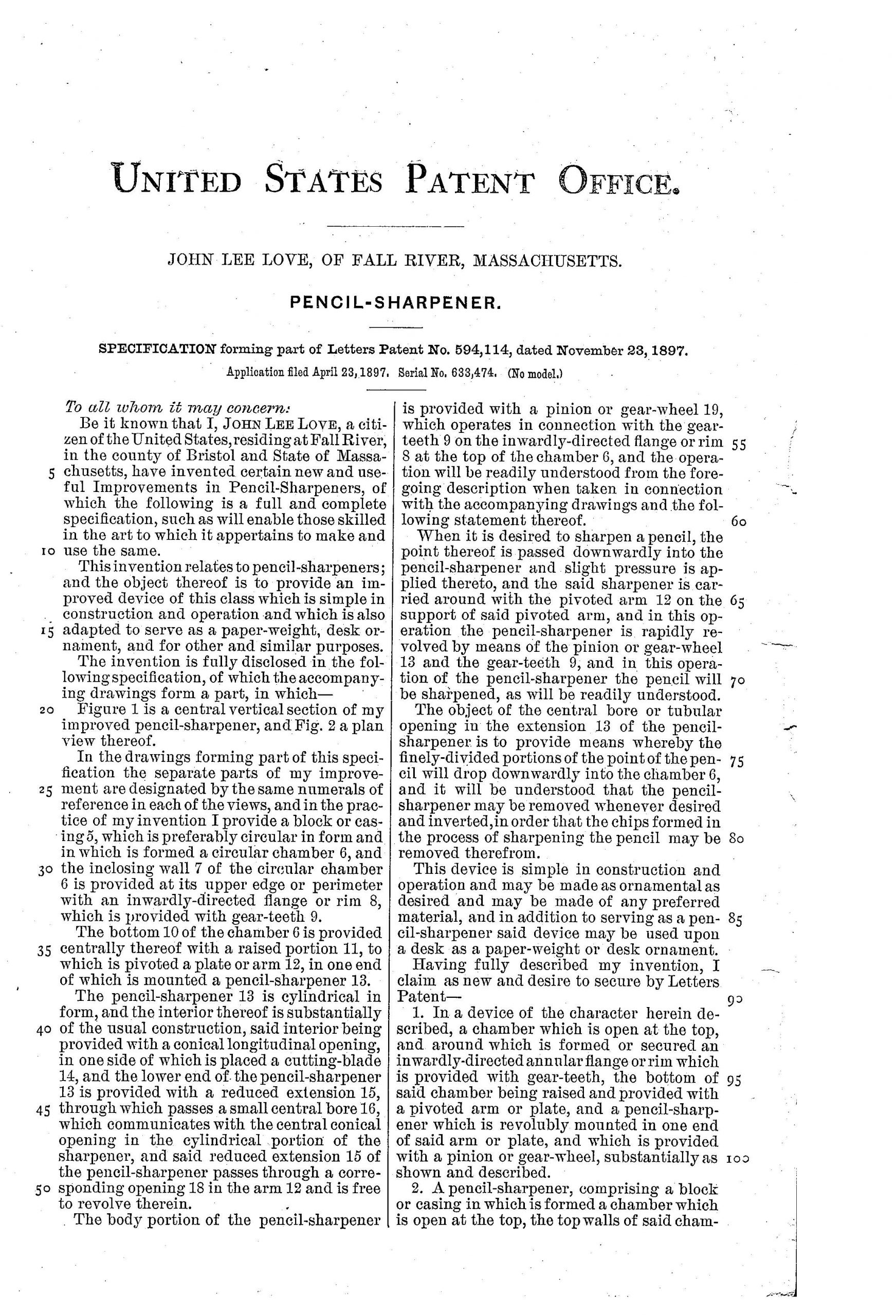
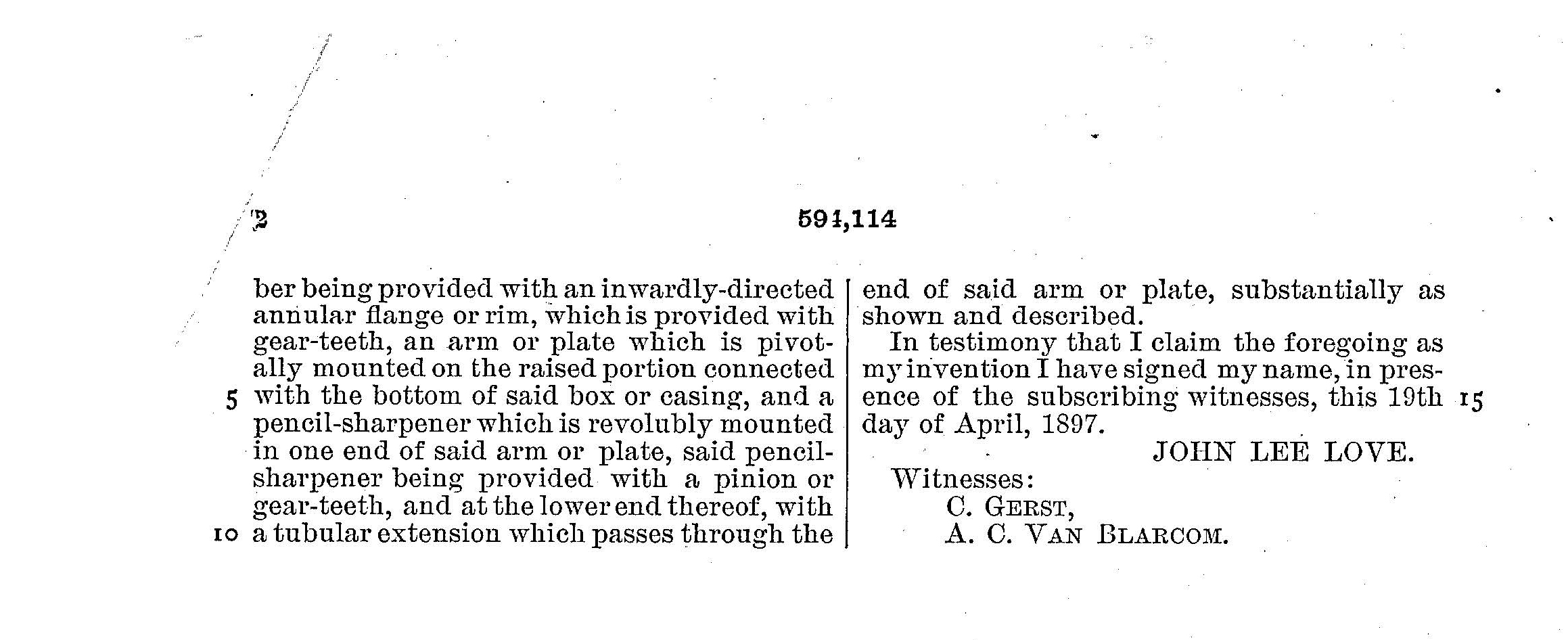
Sources: US census records, 1880; Fall River, Boston, and Newport city directories; Fall River Herald News, February 1, 2013; US Patent Office; Fall River Daily Globe, November 24, 1897; Fall River Daily Globe, December 6, 1897; Boston Globe, August 21, 1895; Fall River Daily Herald, September 5, 1896; Fall River Daily Herald, November 26, 1897; Fall River Daily Evening News, December 4, 1902; Fall River Daily Herald, March 30, 1896.
WILLIAM D. TOMPKINS
— Thoracic Surgeon and Tuskegee Airman —
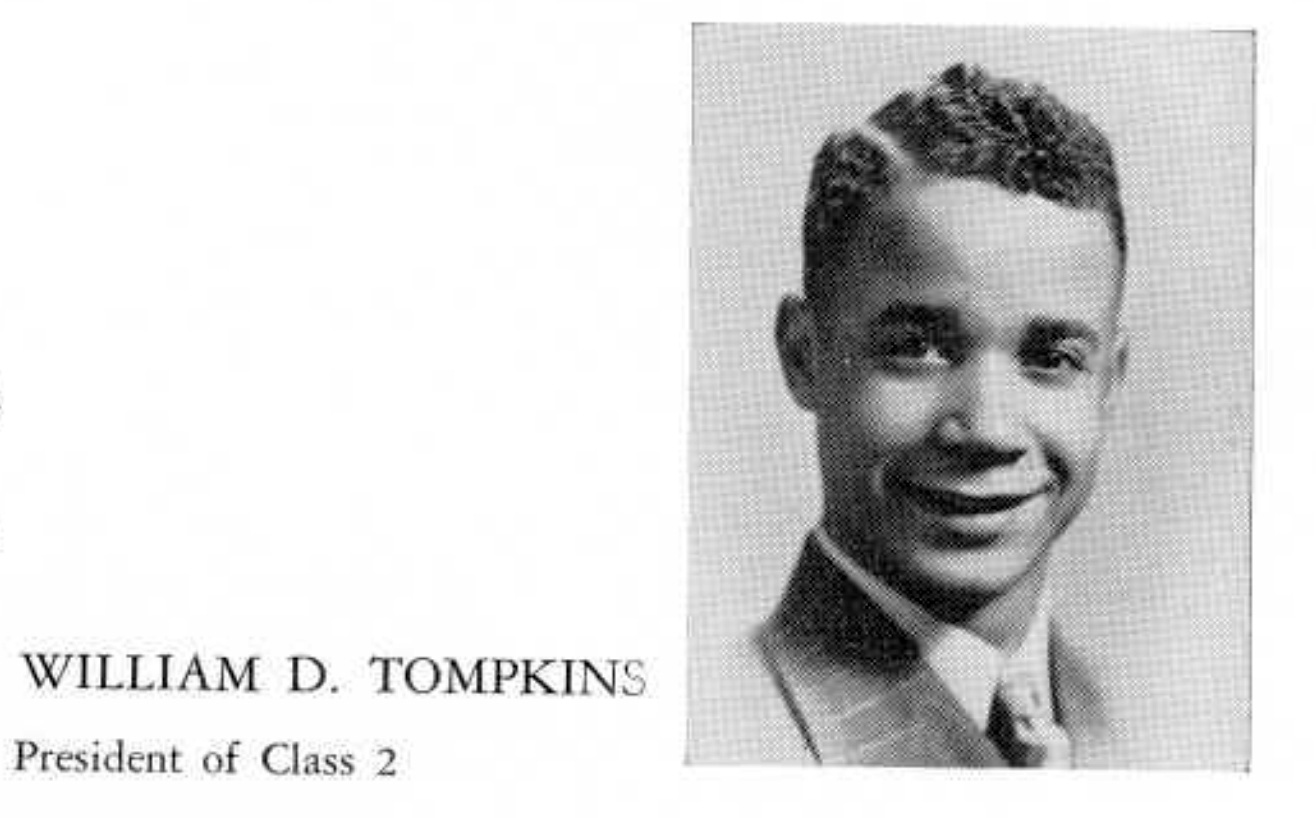
William D. “Sonny” Tompkins was born in Fall River, Massachusetts, on September 28, 1921, to William Donavan Tompkins (1887-1930), from South Carolina, and Ella Mae Cole Tompkins (b. 1892) of Georgia.
In the 1930 US Census, William is eight years old and residing in Fall River at 81 Barrett Street, the home of his aunt, Rebecca Wood and her husband Edmond F. Wood. Included in the household is his father, William Tompkins (head waiter on the steamship Providence, part of the Fall River Line), and his sisters Margaret, Dorothy, and Rebecca. It may well be that Ella Mae had died before this date. In addition, it was shortly after the census was taken that William Sr. died at the age of forty-three. He is buried in Fall River at the North Burial Ground, cause of death unknown.
According to Fall River historian Philip T. Silvia Jr., the Fall River Line was comprised of luxury vessels that “carried passengers on round trip voyages connecting Newport and New York. Operating from 1847-1937, the Old Fall River Line was commonly regarded as providing the most sumptuous examples of coastline cruising available.”
“Sonny” attended local Fall River schools through high school: the Wixon School, Henry Lord Junior High, and B.M.C. Durfee Hight School, graduating in 1939, achieving the elected position of President of Class 2.
The 1940 US Census shows Sonny, at age eighteen (he was the youngest child in his family and the last of his immediate family) still residing with his aunt and uncle at the same location.
According to Cream of the Crop, Fall River’s Best and Brightest by John B. Cummings Jr., Sonny was a Hood Milk eighteen-wheel delivery truck driver after graduating from Durfee High School. The principal of the school, Herbert Pickup, encouraged him to attend college. Sonny completed a year of study at South Carolina State College and then transferred to the University of Michigan.
On February 20, 1943, at the age of twenty, Sonny enlisted in the Army Air Corps and became part of the famed Tuskegee Airmen, with the rank of private. His enlistment record notes he has had two years of college. He served in as a pilot, flight Leader, and instructor.
While serving as an Army pilot stationed at Belfridge Field, Michigan, in March of 1944, Tompkins married Lanore Davis of Detroit, the daughter of Clarence Davis and Lucille Richardson Davis. William was twenty-two and Lanore was nineteen. They divorced in November of 1947.
Sonny returned to Michigan after his tour of duty and received a degree in Biology before attending Tufts Medical School in Massachusetts, graduating in 1951. Dr. Tompkins did his Surgical Residency on the Boston University Service at Boston City Hospital, where he was Chief Resident of the 3rd Surgical Service from 1954-1956 and a Research Fellow in 1956. He also did his Thoracic Surgical Residency at Boston City Hospital.
In 1956, he married a second time to Claire M. MacDonald of Boston, a nurse. Theirs was an interracial marriage in an era when it was forbidden by law in thirty-one states and before its nationwide legalization in 1967 with the landmark Supreme Court ruling in Loving v. Virginia. Massachusetts had repealed anti-miscegenation laws in 1843.
In 2008, Tompkins was the recipient of the Durfee High School Distinguished Alumni Award.
Dr. Tompkins died after a short battle with cancer on January 8, 2011, in Falmouth, Massachusetts, at the age of eighty-nine and was buried with military honors at the Massachusetts National Cemetery in Bourne.
He wife of fifty-four years, Claire, survived him. The couple had four children: Dr. Linda Tompkins, Edward Tompkins, Mrs. Victoria Heydari, and Mrs. Teddie (Claire) Sarmanian. He was also survived by seven grandchildren.
During his almost 40 years of practice, Dr. Tompkins was on the staff of many Boston area hospitals and was Assistant Professor of Surgery, Boston University Medical School, from 1959 to 1974. He was President of the Medical Staff of Longwood Hospital from 1973-1976, and President of the Medical Staff at Whidden Memorial Hospital from 1979-1981. He also served as Chief of Surgery at Massachusetts Osteopathic Hospital from 1984-1988.
Dr. Tompkins was a member of the Massachusetts, Middlesex, and Everett Medical Societies and a Diplomat of the American Board of Surgery. He was also a member of the Falmouth Yacht Club.
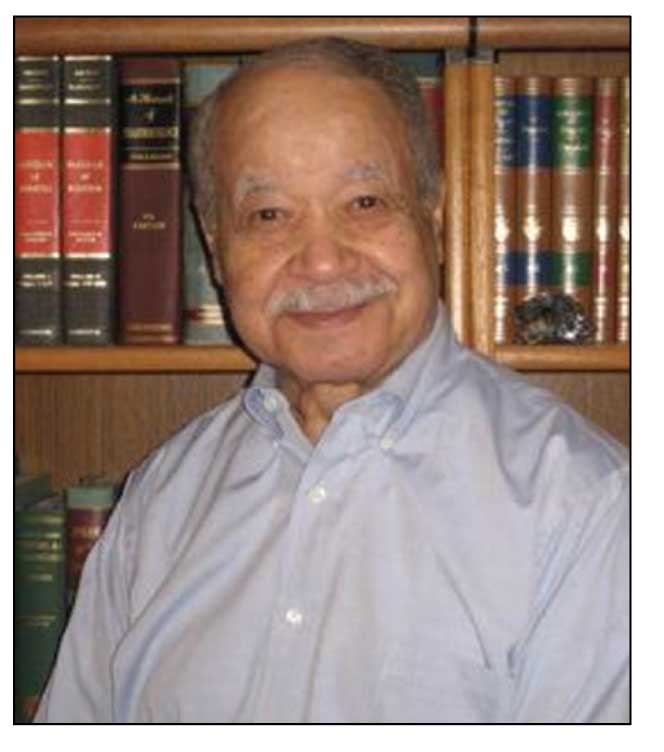
Sources: US census records, 1930, 1940; Cream of the Crop, Fall River’s Best and Brightest by John B. Cummings Jr (Hillside Media, 2014); Durfee Record, 1939; Boston Globe, January 16, 2011; Chapman Funeral Home obituary, https://www.chapmanfuneral.com/obituaries/William-D-Tompkins-MD?obId=20702073; “Sarah Anna Lewis” by Dr. Philip T. Silvia Jr. (Bridgewater State College, n.d.).

